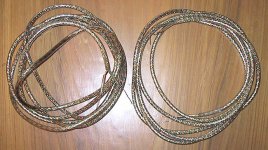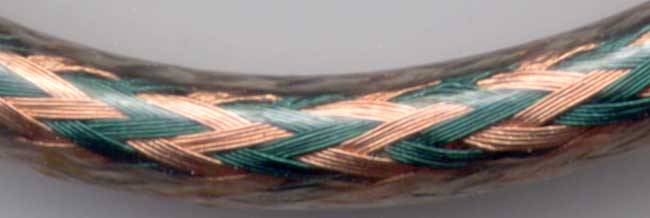While browsing this site: http://www.high-endaudio.com/RC-SpkrCab.html I noticed interesting comment on Polk speaker cables. Yesterday, I met another local audiophile who had those cables and he indeed confirmed that they are one of the best.
Any idea about availability of those, as it seems like they are very rare now.
Any idea about availability of those, as it seems like they are very rare now.
If you really want a low inductance solution with less capacitance than the Polk wire, try 4 parallel runs of RG-8. Connect all the shields together, all the cores together, and you have 0.018 uH/ft at 120 pF/foot. For an 8 foot cable that's 0.144 uH and 0.001 uF. Resistance is truly negligeable because each RG-8 is about 12 gauge, so the 4 combined are close to 6 gauge.
The only problem is you'll find the wire inside the cabinet presents an order of magnitude more series impedance than the lead-in...
Cheers,
Francois.
The only problem is you'll find the wire inside the cabinet presents an order of magnitude more series impedance than the lead-in...
Cheers,
Francois.
SY said:If these were the ones from late '70s/early '80s, they were total amp-killers. You can get the same result by hanging a 0.1uF cap across some zip cord- or, even better, orange Home Despot wire
I was told that the secret to the sound of those was in special braiding. AFAIK, the HD wires don't use that technique.
Peter Daniel said:
I was told that the secret to the sound of those was in special braiding. AFAIK, the HD wires don't use that technique.
SY was being facetious. The braiding which reduces series inductance also bumps up the parallel capacitance quite a lot, hence the remark about sticking a 0.1 uF cap in there. I like multiple fat coax for speaker cables because you get the benefit of low inductance with reasonable amounts of parallel capacitance. Note the WireWorld speaker cables are also coax, although I think my arrangement is more cost-effective than theirs.
Of course, for *really* good results, I'd eschew binding posts, klugy things that they are, go with UHF connectors on amp and speaker, and run coax on the internal wiring as well.
Francois.
You could drop by:
http://clubpolk.polkaudio.com/forum/
Some of the members have those cables. They even show up in the flea market on occasion. At the very least, they'd be happy to share their opinions of them.
regards
Dave
http://clubpolk.polkaudio.com/forum/
Some of the members have those cables. They even show up in the flea market on occasion. At the very least, they'd be happy to share their opinions of them.
regards
Dave
DSP_Geek,
so for your recommended amp -> speaker connections you would use one coaxial cable for both the positive and negative connections or perhaps a dual twisted crossconnected design (like Jon Risch's). By UHF connections do u mean BNC plugs, or maybe F or H type connectors?. I'm in the process of making a chassis for my recently completed 3875 gainclone and will be making my own speakers, thus I am free to implement any connections I see fit.
Peter,
Sorry for diverting your thread topic. Kudos to yourself and Brian for developing such great kit. I was surprised how quickly an amp could be made, turning it on the first time sure was nerve racking, but oh what sweet music it makes. I'm listening to right now as I type, surprising how much the sound is changing as it "burns in". The only problem is I think you might have started another addiction for me
On the topic of the cables, I was wondering if they are still in production today, I travel yearly to Japan and my inlaws live there. If the name of the Japanese manufacturer could be found, I could attempt to hunt it down.
so for your recommended amp -> speaker connections you would use one coaxial cable for both the positive and negative connections or perhaps a dual twisted crossconnected design (like Jon Risch's). By UHF connections do u mean BNC plugs, or maybe F or H type connectors?. I'm in the process of making a chassis for my recently completed 3875 gainclone and will be making my own speakers, thus I am free to implement any connections I see fit.
Peter,
Sorry for diverting your thread topic. Kudos to yourself and Brian for developing such great kit. I was surprised how quickly an amp could be made, turning it on the first time sure was nerve racking, but oh what sweet music it makes. I'm listening to right now as I type, surprising how much the sound is changing as it "burns in". The only problem is I think you might have started another addiction for me
On the topic of the cables, I was wondering if they are still in production today, I travel yearly to Japan and my inlaws live there. If the name of the Japanese manufacturer could be found, I could attempt to hunt it down.
Cobra cable was one of the very 1st exotic speaker cables. We sold them (for a while) in the late 70s. They were indeed amp killers -- one of the reasons we quit selling them.
I recently flogged off all 4 sets that i had.
They used 2 colors of enameled wire braided over a plastic core at approximatly 90 degrees with a sheath of clear plastic.
Besides the capacitance issue, there was a tendency for the enamel to scratch & short-circuit. They were also a pain to re-terminate.
dave
I recently flogged off all 4 sets that i had.
They used 2 colors of enameled wire braided over a plastic core at approximatly 90 degrees with a sheath of clear plastic.
Besides the capacitance issue, there was a tendency for the enamel to scratch & short-circuit. They were also a pain to re-terminate.
dave
Attachments
zBuff said:DSP_Geek,
so for your recommended amp -> speaker connections you would use one coaxial cable for both the positive and negative connections or perhaps a dual twisted crossconnected design (like Jon Risch's). By UHF connections do u mean BNC plugs, or maybe F or H type connectors?. I'm in the process of making a chassis for my recently completed 3875 gainclone and will be making my own speakers, thus I am free to implement any connections I see fit.
The Risch connection was how I got turned onto RG-8 in the first place, but I didn't like the way it sounded at all. I ended up just using the cores in parallel for the hot and the shields in parallel for the ground - that was a bit darker, but as it turned out all the apparent brightness of the other setup (and the other cable I compared it to) was, for lack of a better term, junk, which almost seemed to be nothing more than distortion. Once we got used to the darker presentation, we noticed (on vinyl) the soundstage had *lots* of depth, way more than the previous presentation, which was mostly two-dimensional between the speakers.
Again, Your Mileage May Vary. The aforementioned audition was on Quad electronics and KEF speakers. Later listenings on Threshold amps and Apogee speakers driven by a high end CD player were not nearly so conclusive, although we may have perceived some slight improvement in the midrange.
A UHF is a big-*** connector suitable for RG-8. They also go by PL-259 (plug) and SO-239 (socket). The plug's a bit tedious to solder; you might be well advised to ask a local ham for advice if you know one. Before you go to all that trouble, though, just get a single length of RG-8, strip the ends, and use it with your current gear on binding posts like any ordinary speaker cable. That'll give you an idea whether you like it at about $0.50/ft, before you drop money and effort on connectors & such.
Cheers,
Francois.
- Status
- This old topic is closed. If you want to reopen this topic, contact a moderator using the "Report Post" button.
- Home
- Loudspeakers
- Multi-Way
- Polk (Cobra) Speaker Cables

